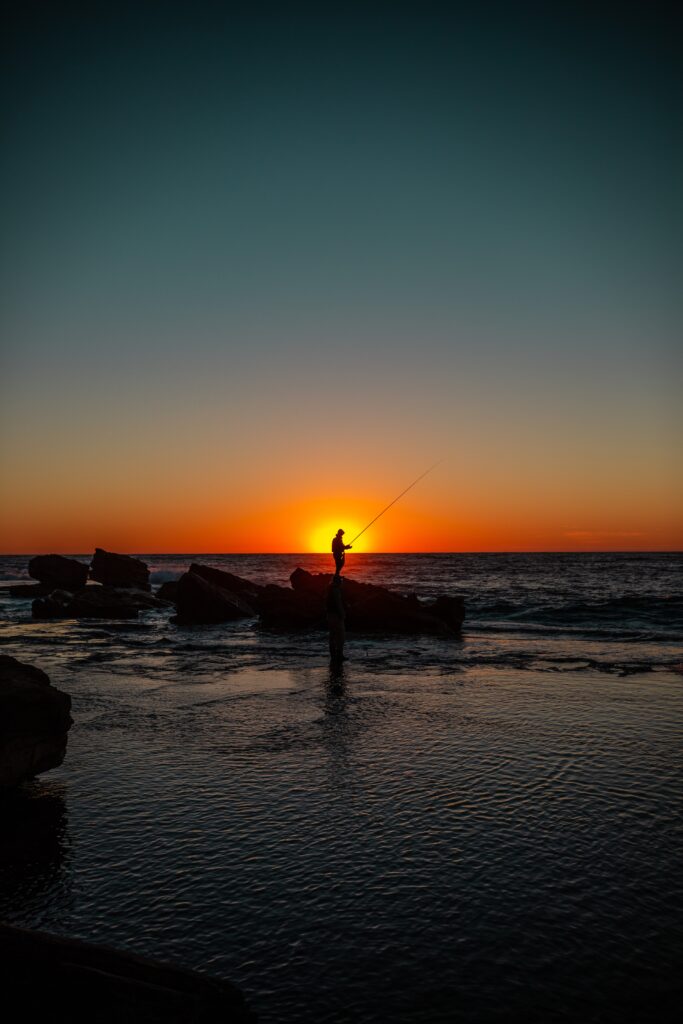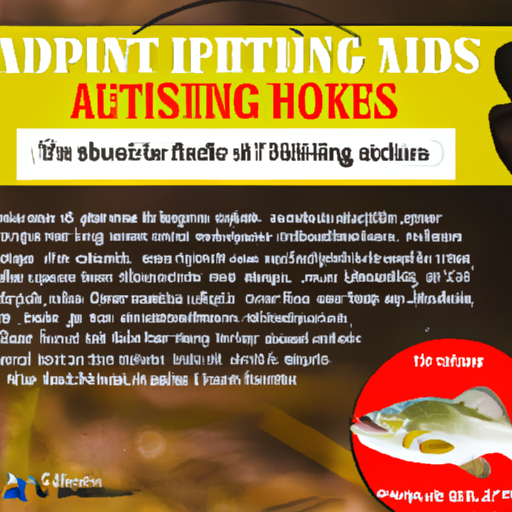Are you a beginner angler looking to try your luck in shallow waters? Look no further! “Tips For Fishing In Shallow Waters: A Novice’s Guide” is here to help you reel in the big catch. This comprehensive guide is packed with expert advice, easy-to-follow techniques, and insider tips to help you navigate the challenges of shallow water fishing. Whether you’re a freshwater or saltwater enthusiast, this guide has got you covered. Get ready to embark on your fishing adventure and make the most of those shallow waters!

Choosing the Right Equipment
Fishing in shallow waters requires specific equipment that is suited to the unique conditions of these environments. To ensure a successful fishing outing, it is important to select the right fishing rod, reel, fishing line, hooks, and lures.
Selecting the Right Fishing Rod
Choosing the right fishing rod is crucial when fishing in shallow waters. Opt for a rod that is lightweight yet sturdy, as it needs to have the flexibility to handle the varied conditions and different fish species that may be encountered in shallow waters. A medium-action rod, around 6 to 7 feet long, is generally a good choice for shallow-water fishing. This length provides enough casting distance while still allowing for precise control.
Choosing the Right Fishing Reel
When it comes to selecting a fishing reel for shallow-water fishing, go for a spinning reel. Spinning reels are easy to handle and provide excellent versatility, making them suitable for targeting fish species found in shallow waters. Look for a reel that has a smooth drag system and a reasonable line capacity to handle any potential battles with larger fish.
Picking the Right Fishing Line
The fishing line plays a vital role in shallow-water fishing. Choose a fishing line that is strong enough to handle potential obstacles such as weeds or rocks, but also has the sensitivity to feel the light bites of fish in shallow waters. Monofilament lines are a good choice for beginners, as they are affordable and offer a good balance of strength and sensitivity.
Selecting Appropriate Hooks and Lures
Selecting the right hooks and lures is crucial for enticing fish to bite in shallow waters. Depending on the fish species being targeted, different hook sizes and types may be required. It is always a good idea to carry a variety of hooks in your tackle box to ensure you are prepared for any situation. Additionally, using lures that match the natural prey of the fish species in the area can significantly increase your chances of a successful catch.
Understanding the Fish Species
Researching and understanding the habits and behavior of the fish species found in shallow waters is essential for successful fishing. By familiarizing yourself with their feeding patterns, specific locations, and the best time to fish for them, you can significantly improve your chances of a productive fishing trip.
Researching the Habits and Behavior of Shallow-water Fish
Take the time to research and learn about the habits and behavior of the fish species commonly found in the shallow waters you plan to fish in. Understanding their preferred habitats, feeding patterns, and behavioral tendencies can help you determine the best fishing techniques and approaches to use. For example, some fish species may be more active during certain times of the day or exhibit specific behaviors when feeding.
Identifying Common Fish Species in Shallow Waters
Becoming familiar with the most common fish species found in shallow waters can greatly enhance your fishing experience. Take note of the various species that inhabit the area you plan to fish in and learn about their physical characteristics, preferred diets, and typical behavior. This knowledge will allow you to better tailor your bait and lure choices to attract the specific species you are targeting.
Understanding the Feeding Patterns of Fish in Shallow Waters
Understanding the feeding patterns of fish in shallow waters is crucial for increasing your chances of success. Many fish in shallow waters rely on ambush tactics or become more active during certain feeding times. By identifying these patterns, you can adjust your fishing techniques, such as varying your retrieval speed or using different lures, to maximize your chances of enticing a bite.
Learning the Best Time to Fish for Different Species
Different fish species have varying activity levels and feeding preferences throughout the day. Research and determine the best times to fish for the specific species you are targeting in shallow waters. Early morning and late evening are typically regarded as prime fishing times, as many fish are more active during these periods. However, it is important to remember that fish behavior can vary depending on the environmental conditions, so experimenting and adapting to changing circumstances is key.

Locating Shallow-water Fishing Spots
Finding the right fishing spots in shallow waters is essential for a successful fishing trip. By exploring shoreline structures and vegetation, looking for weedy areas and algae blooms, finding underwater structures and obstacles, and identifying shallow-water channels and currents, you can pinpoint where the fish are likely to be.
Exploring Shoreline Structures and Vegetation
Shoreline structures, such as fallen logs, rocks, or docks, provide excellent opportunities for fish to seek shelter and food in shallow waters. Explore these areas carefully, as they can often attract a variety of fish species. Additionally, vegetation, such as reeds or lily pads, can create ideal habitats for fish, providing cover and acting as breeding grounds. Pay close attention to these areas, as they are often hotspots for finding fish in shallow waters.
Looking for Weedy Areas and Algae Blooms
Weedy areas and algae blooms are magnets for fish in shallow waters. These areas provide a rich food source for many species and offer shelter from predators. Look for patches of submerged or emergent weeds, as well as areas with visible algae blooms, as these are excellent spots to target. Casting your bait or lure near these areas can often yield great results.
Finding Underwater Structures and Obstacles
Underwater structures and obstacles, such as submerged logs, rocks, or sunken boats, can act as hiding places for fish in shallow waters. These structures often attract baitfish and other prey, which in turn attracts larger predatory fish. Utilize a fishfinder or polarized sunglasses to identify these underwater features and cast your line strategically to increase your chances of encountering fish.
Identifying Shallow-water Channels and Currents
Shallow-water channels and currents can provide ideal feeding grounds for fish. Look for areas where the water appears to have a slightly deeper channel or notice areas where the current is faster. These areas can concentrate fish and increase your chances of a successful catch. By studying the water flow and identifying these features, you can improve your efficiency and success when fishing in shallow waters.
Mastering the Casting Technique
Mastering the casting technique is essential to accurately present your bait or lure in shallow waters. Perfecting the basic overhead cast, learning the sidearm cast, practicing the skipping cast, and understanding the importance of casting accuracy will greatly enhance your chances of enticing fish to bite.
Perfecting the Basic Overhead Cast
The basic overhead cast is a fundamental technique that every angler should master. It involves smoothly and accurately casting your line by drawing the rod back over your shoulder and then casting it forward using a fluid motion. Practice this technique to develop your casting distance and accuracy, allowing you to reach specific targets in shallow waters with ease.
Learning the Sidearm Cast for Shallow Water
In shallow waters, there may be limited vertical clearance, making the sidearm cast a valuable technique. The sidearm cast involves keeping the rod parallel to the water’s surface and casting the line to the side. This technique allows for accurate and low-trajectory casts, ideal for fishing in areas with overhanging vegetation or tight spaces.
Practicing the Skipping Cast for Precision
The skipping cast is a technique employed when you want to present your bait or lure to fish in hard-to-reach areas, such as under docks or overhanging trees. To perform a skipping cast, cast your line with enough force to make the bait or lure skip across the water’s surface, reaching areas that would otherwise be inaccessible. This technique requires practice to achieve the desired precision and accuracy.
Understanding the Importance of Casting Accuracy
Casting accuracy is critical when fishing in shallow waters. The ability to place your bait or lure precisely where the fish are located increases your chances of enticing a bite. Practice your casting skills regularly, aim for specific targets, and adjust your casting technique as needed to ensure your presentation is as accurate as possible.

Using Proper Fishing Techniques
Utilizing proper fishing techniques is essential for success in shallow-water fishing. By employing slow and stealthy approaches, adjusting your retrieve speed, experimenting with different fishing techniques, and employing sight fishing methods, you can maximize your chances of enticing fish to bite.
Utilizing Slow and Stealthy Approaches
In the relatively shallow and clear waters of shallow fishing spots, it is crucial to avoid spooking the fish. Utilize slow and stealthy approaches when moving along the shoreline or in a boat, keeping noise and disturbances to a minimum. By being mindful of your movements and maintaining a low profile, you can increase your chances of remaining undetected and getting closer to the fish without startling them.
Adjusting Your Retrieve Speed for Shallow Waters
The retrieve speed of your bait or lure can greatly influence the success of your fishing endeavors in shallow waters. Experiment with different retrieve speeds to determine what is most effective for the specific fish species you are targeting. In some instances, a slow and steady retrieve may be preferred, while in other situations, a faster and more aggressive retrieve may be necessary to entice a bite.
Experimenting with Different Fishing Techniques
Shallow-water fishing provides ample opportunities to experiment with various fishing techniques. Try different techniques, such as jigging, twitching, or jerking, to determine what works best for the specific fish species you are targeting. Keep in mind that different techniques may be more effective depending on the time of day, weather conditions, or the specific location you are fishing in.
Employing Sight Fishing Methods
Sight fishing can be an exciting and effective technique when fishing in shallow waters. Keep an eye out for fish cruising near the surface or in shallower areas and cast your bait or lure directly in front of them. Sight fishing requires patience, keen observation skills, and timing, but it can prove to be highly rewarding when done successfully.
Bait and Lure Selection
Choosing the right bait and lures is crucial when fishing in shallow waters. By opting for natural baits, selecting the right lure colors for the conditions, choosing topwater lures for surface fishing, and using weedless lures to avoid snags, you can optimize your chances of enticing fish to bite.
Opting for Natural Baits in Shallow Waters
Using natural baits, such as worms, minnows, or small crustaceans, can be highly effective in shallow waters. These baits closely resemble the prey that fish are accustomed to feeding on in their natural habitats. Depending on the fish species you are targeting, choose the appropriate natural bait that best matches their feeding preferences.
Choosing the Right Lure Colors for the Conditions
Lure color selection is of utmost importance when fishing in shallow waters. The choice of lure color should largely depend on water clarity, weather conditions, and the behavior of the fish species you are targeting. In general, use brighter and more vibrant colors in clear water and during sunny days, while opting for darker or more natural colors in murky water or on overcast days.
Selecting Topwater Lures for Surface Fishing
Topwater lures can be highly effective when fishing in shallow waters, as they create a commotion on the water’s surface that attracts the attention of fish. These lures imitate insects or small prey that fish feed on at the water’s surface. Experiment with different topwater lures, such as poppers, frogs, or floating minnows, to determine which ones are most effective for the fish species you are targeting.
Using Weedless Lures to Avoid Snags
Weeds and vegetation are common in shallow-water fishing spots. To avoid getting your lure caught and wasting valuable fishing time, consider using weedless lures. Weedless lures are designed to minimize the chances of snagging on weeds or other structures, allowing you to navigate through vegetation without getting entangled. These lures often have specially designed hooks or options for adding a weed guard.

Making Use of Effective Fishing Rigs
Using effective fishing rigs can greatly enhance your chances of success in shallow-water fishing. Setting up a Carolina Rig for bottom fishing, using a Texas Rig to fish in thick vegetation, trying the Drop Shot Rig, and employing the Float and Fly Rig for suspended fish can all be effective methods in shallow waters.
Setting up a Carolina Rig for Bottom Fishing
The Carolina Rig is an excellent choice for bottom fishing in shallow waters. It consists of a sliding sinker, a swivel, a fluorocarbon or monofilament leader, and a hook. This rig allows you to present your bait near the bottom while still maintaining a natural and enticing movement. It is particularly effective when targeting fish species that feed close to the bottom, such as bass or catfish.
Using a Texas Rig to Fish in Thick Vegetation
When fishing in thick vegetation, such as dense weed beds or lily pads, the Texas Rig is a popular and effective option. The Texas Rig consists of a bullet-shaped weight, a plastic worm or creature bait, and a hook. The weight is inserted into the bait, allowing it to be presented weedless and preventing snags. This rig is ideal for enticing fish hiding in the thick cover of vegetation.
Trying the Drop Shot Rig in Shallow Waters
The Drop Shot Rig is a versatile and effective rig for fishing in shallow waters. It involves attaching a weight at the end of the line and suspending a hook and bait above it. This rig allows for precise control of the bait’s depth and is particularly effective for targeting suspended fish in shallow waters. Experiment with different bait options, such as soft plastics or live bait, to determine what works best for the fish species you are targeting.
Employing the Float and Fly Rig for Suspended Fish
The Float and Fly Rig is an excellent choice when targeting suspended fish in shallow waters. This rig consists of a small float or bobber, a leader line, and a lightweight jig or fly. The float suspends the bait at a desired depth, allowing you to present it naturally to fish suspended in the water column. This rig can be highly effective for enticing hesitant or finicky fish to bite.
Understanding Weather and Water Conditions
Understanding the weather and water conditions is essential when fishing in shallow waters. By monitoring the water temperature and clarity, taking note of wind and current directions, considering the effects of tides and moon phases, and adapting to changing weather patterns, you can increase your chances of a successful fishing experience.
Monitoring the Water Temperature and Clarity
Water temperature and clarity greatly influence fish behavior in shallow waters. Fish tend to be more active and feed more aggressively when the water temperature is ideal for their metabolism. Additionally, water clarity affects how fish perceive and react to different fishing presentations. Pay attention to changes in water temperature and clarity and adjust your fishing techniques accordingly.
Taking Note of Wind and Current Directions
Wind and current direction have a significant impact on fish behavior in shallow waters. Wind can create wave action and cause baitfish to congregate in specific areas, attracting larger predator fish. Currents can carry food sources and concentrate fish in certain locations. Take note of wind and current directions and cast your line accordingly to present your bait or lure in areas where fish are likely to be congregating.
Considering the Effects of Tides and Moon Phases
If you are fishing in tidal waters, it is important to consider the effects of tides and moon phases on fish behavior. During certain phases of the tide, water movement can stir up baitfish and increase fish activity. Additionally, the gravitational pull of the moon can influence fish feeding patterns. Familiarize yourself with the tidal charts and moon phases to plan your fishing trips accordingly.
Adapting to Changing Weather Patterns
Weather patterns can change rapidly, and it is important to adapt your fishing approach accordingly. Fish may react differently to varying weather conditions, such as changes in temperature, barometric pressure, or cloud cover. Stay flexible and be prepared to adjust your bait and lure selection, fishing techniques, and fishing spots in response to changing weather patterns. Observing how fish respond to these changes can provide valuable insights for future fishing trips.

Safety Tips for Shallow-water Fishing
Ensuring your safety is paramount when fishing in shallow waters. By wearing appropriate safety gear and a life jacket, being aware of potential hazards, informing others of your fishing location, and practicing responsible catch and release techniques, you can have an enjoyable and safe fishing experience.
Wearing Appropriate Safety Gear and Life Jacket
Remember to wear appropriate safety gear while fishing in shallow waters, including a life jacket. Shallow waters can still pose risks, such as unexpected drop-offs or strong currents, making it important to prioritize your safety. Always wear a properly fitted life jacket, regardless of your swimming ability, to ensure your safety in case of an accident or emergency.
Being Aware of Potential Hazards in Shallow Waters
Shallow waters can harbor potential hazards that should be taken into consideration. Be mindful of submerged rocks, sharp objects, or hidden obstacles that can pose a risk to you or your equipment. Additionally, be cautious of inclement weather conditions that may arise suddenly. By remaining vigilant and aware of your surroundings, you can minimize potential hazards and keep yourself safe while fishing.
Informing Others of Your Fishing Location
When fishing in shallow waters, it is always a good idea to inform someone else about your fishing plans. Share your fishing location, estimated duration of your trip, and expected return time with a trusted person. This way, they can be alerted in case of an emergency or if you fail to return within the expected timeframe.
Practicing Responsible Catch and Release Techniques
To preserve and protect fish populations in shallow waters, practicing responsible catch and release techniques is crucial. Handle fish with care, minimizing any potential harm or stress caused to them. Use barbless hooks to facilitate easy release, and return the fish to the water as quickly and gently as possible to ensure their survival. Remember, responsible fishing practices contribute to the sustainability of fish populations for future generations.
Learning from Experienced Anglers
Learning from experienced anglers can significantly enhance your shallow-water fishing skills. By joining a local fishing club or community, participating in guided fishing trips, attending workshops and seminars, and engaging with online fishing communities, you can tap into a wealth of knowledge and gain valuable insights from those with more experience.
Joining a Local Fishing Club or Community
One of the best ways to improve your fishing skills is by joining a local fishing club or community. These groups often hold regular meetings, outings, and tournaments where you can learn from experienced anglers, exchange tips and techniques, and gain access to valuable local knowledge. In addition to honing your fishing skills, you can also develop lasting friendships with fellow anglers who share the same passion.
Participating in Guided Fishing Trips
Guided fishing trips are an excellent way to learn from experienced anglers while enjoying a day on the water. Booking a guided fishing trip allows you to benefit from the expertise and knowledge of professional guides who have extensive experience fishing in shallow waters. They can provide valuable insights, teach you specific techniques, and help you adapt your approach to maximize your success.
Attending Workshops and Seminars
Workshops and seminars focused on shallow-water fishing are great opportunities to learn from experts in the field. These events often cover a wide range of fishing topics, including equipment selection, techniques, and understanding fish behavior. Attend these educational sessions to gain new perspectives, expand your knowledge base, and interact with other anglers who share your passion.
Engaging with Online Fishing Communities
Engaging with online fishing communities and forums can be a valuable source of information and shared experiences. Participate in discussions, ask questions, and share your own fishing stories and successes. Online fishing communities often provide a platform for anglers of all skill levels to connect, learn, and obtain advice from more experienced individuals.
In conclusion, fishing in shallow waters offers a unique and rewarding experience for novice anglers. By choosing the right equipment, understanding the fish species and their habits, locating suitable fishing spots, mastering casting techniques, using proper fishing techniques and rigs, selecting the right baits and lures, considering weather and water conditions, prioritizing safety, and learning from experienced anglers, you can greatly enhance your chances of success. Remember to always respect the environment and practice responsible angling to preserve and protect fish populations for future generations to enjoy. So grab your gear, venture into the shallows, and enjoy the thrill of a successful fishing trip in shallow waters.





